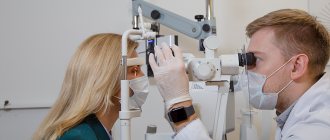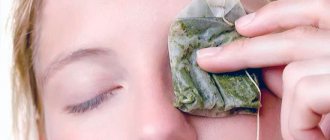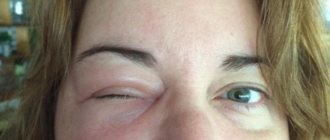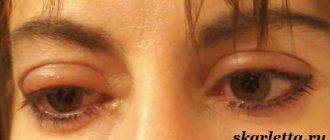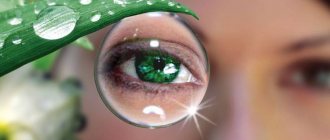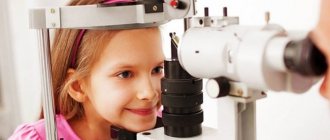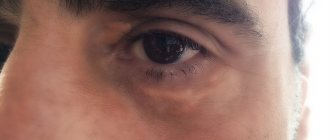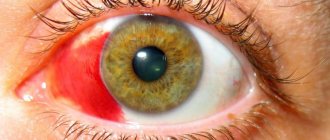Definition of disease
Demodicosis of the eyelids is an inflammatory process that damages the skin. The tick that contributes to the development of the disease is small. It can only be detected under a microscope. It is concentrated in the area of the eyelids, eyebrows, forehead, and nasolabial folds.
Demodectic mange – loss of eyelashes
Demodex on the eyelids is diagnosed equally in both men and women.
Causes
A mite that lives on the eyelids is accompanied by painful symptoms if the conditions of its coexistence with the carrier are not satisfactory. Demodicosis can be primary and secondary. The primary one is formed on the healthy skin of the eyelids, and the secondary one is formed against the background of other skin pathologies (papilloma on the eyelid, benign neoplasms, blepharitis). The following factors can influence the development of demodicosis of the eyelids:
- heat, the influence of the sun's rays in the summer-spring period;
- taking too hot procedures - bath, sauna, sauna;
- decrease in the body's defenses;
- increased skin acidity;
- visual impairment caused by myopia, farsightedness;
- diseases of the endocrine, nervous, vascular systems;
- high temperature at home;
- surgery on the eyeball.
Read more about whether myopia can be cured here.
Antihistamine drops
When allergic reactions are observed, antihistamine eye drops are good:
- Acular
- Okumetil
- Dexamethasone
More details about them below:
Acular
Therapeutic effect: Thanks to the components of the drug, it can be used as an anti-inflammatory.
Contraindications to the drug: individual intolerance, pregnancy.
Okumetil
Therapeutic effect: The drug reduces swelling of the eyelids, thanks to the active substances included in its composition. Histamine receptors are blocked and blood vessels narrow.
Contraindications to the drug: pregnancy and lactation period, hypersensitivity, up to two years; glaucoma, epilepsy, gastrointestinal diseases, dry eye syndrome. Also bronchial asthma, pathologies of the cardiovascular system, thyroid dysfunction, atherosclerosis, diabetes mellitus.
Dexamethosone
Therapeutic effect: When used, the anti-inflammatory and anti-allergic effect is strongly manifested.
Contraindications to the drug: hypersensitivity to the components of the drug; tuberculous, fungal, viral eye lesions, trachoma, glaucoma, epithelial damage to the cornea.
When using certain medications, you should definitely consult a specialist. The best treatment is under the supervision of a professional!
Symptoms
With the development of demodicosis of the eyelids, an inflammatory process is formed. It is associated with blepharitis, which has received active development in this area.
When the pathology damages the eyeball, the patient may be diagnosed with blepharoconjunctivitis.
Symptoms of the disease appear at a certain time. It is expressed as follows:
- itching and burning on the skin of the eyelids, which intensify when using cosmetics;
- swelling and hyperemia;
- purulent crusts along the edges of the skin of the eyelids;
- peeling;
- eyelash loss.
If the pathological process affects the eyeball, then active lacrimation, redness and dryness of the conjunctiva occur. The organs of vision quickly get tired, the acuity of visual function decreases.
About the causes and treatment of dry eye syndrome in the material.
With demodicosis of the eyelids, people often experience the formation of styes.
How to do massage at home?
Massage for demodicosis of the eyelids is part of a comprehensive treatment. It is performed in several stages:
- In the morning and evening, treat the edges of the eyelids with alcohol tincture of calendula using cotton swabs. You can purchase the drug at any pharmacy. The treatment must be carried out very carefully so that the product does not get into the eyes. Otherwise, it can lead to irritation. As soon as the eyelids are dry, you need to close them tightly and apply the healing cream with a light touch of your fingertips: Demalan, Stop Demodex, Glycodem. They suppress tick activity. The duration of this stage is 21 days. Then take a break for 2 weeks and proceed to the second stage.
- After treatment with alcohol tinctures, massage the edges of the eyelids using the drug Blepharogel. The duration of this stage will be 3 weeks. To get the maximum effect, you can start taking the homeopathic drug Sulfur iodine, the dosage of which will be prescribed by your doctor.
The massage will be effective if it is performed not with your fingertips, but with the help of a special stick, which can be purchased at a pharmacy . This device will allow you to squeeze the tick out of the deep layers of the dermis where it lives.
Before starting the massage, apply any anesthetic drops to your eyes. Then gently massage the edge of the eyelid with a stick for 5-10 minutes. You need to move from the middle to the lash line.
Treatment
Medications
The doctor will be able to prescribe an effective medicine for demodicosis of the eyelids, taking into account the type and stage of the pathology, as well as the individual characteristics of the pathology.
Ointments
For the effective treatment of demodicosis of the eyelids, there are a lot of effective drugs, presented in the form of ointments. Among them are the following popular means:
- Sulfuric ointment. This drug can disinfect, destroy parasites and speed up the healing process. Sulfur ointment is an effective, but inexpensive remedy. The only drawback is the unpleasant aroma and contamination of things. Use the ointment to treat the skin, avoiding contact with hair areas. The duration of treatment will be 7-12 days.
- Permethrin ointment. This is an insecticidal and acaricidal drug that has a local effect. Due to the active components that penetrate the parasite’s body, it is possible to quickly immobilize and destroy it. Skin treatment should be carried out 2-3 times a day. The duration of treatment is 14 days. The drug should not be used by children under 3 years of age.
- Ointment Yam. This dermatological medicine is based on components that are effective against parasites and fungi. Apply the ointment 2 times a day for 14 days.
- Ichthyol ointment. Its action is aimed at destroying pathogenic microflora and pain. Apply the drug 3 times a day.
Dexa-Gentamicin is described in this article.
Ichthyol ointment destroys pathogenic microflora and pain
If it is necessary to treat demodicosis of the eyelids on delicate skin, then you should pay attention to medications such as Blefarogel, Demalan, Zinc-ichthyl ointment. They are specially designed for delicate skin, as they do not irritate the mucous membranes and do not contain toxins.
Drops
To combat the disease, you can use drugs in the form of drops. But they should not be dripped, but used to treat the skin of the eyelids, since this is where mites live.
You need to drop the product onto a cotton swab and apply it to your eyelids. You can also massage with your finger. But to eliminate itching, dryness and inflammation, eye drops can be dripped into the conjunctival sac.
The treatment regimen may include the following acaricidal drops:
- Carbohol,
- Physostegmine,
- Phosphacol.
These products should be used not for instillation, but for treating the edges of the eyelids.
To treat demodicosis complicated by secondary infection, drops with an antibacterial effect are used. The following drops can be called effective:
- Levomycytinaceae,
- Levoflaxacin,
- Ciprofloxicin,
- Tobrex,
- Dexa-Gentamicin (ointment). Levomycetin, eye drops that will help cure demodicosis, more details here.
Also read about Ciprofloxin at this link.
To relieve the unpleasant symptoms of allergies on the eyelids, it is worth using antihistamine drops:
- Akular,
- Okumetil,
- Dexamethasone.
Dexamethasone is used for allergies on the eyelids
Folk remedies
To treat demodicosis of the eyelids, non-traditional remedies are used as often as pharmaceutical ones. The following recipes remain effective:
- Wormwood decoction. You need to take 40 g of raw materials, pour 1 liter of boiling water. Leave for 2-3 minutes. Take the filtered decoction 6 times a day, 50 ml. On the first day of therapy, take it every hour, then after 2 hours, and on the third day - after 3 hours.
- Aloe juice compresses. With the help of such compresses it is possible to relieve swelling and hyperemia. Take fresh leaves of the plant, wash, cut and apply the inside to the inflamed skin of the eyelids.
- Oak bark decoction. This remedy also effectively combats the unpleasant symptoms of demodicosis. You need to take 10 g of raw material and pour 200 ml of hot water. Leave for 30 minutes. Filter the broth, moisten cotton pads and apply to eyelids. Change them every 10 minutes.
- Calendula infusion. You can find it in the first aid kit. Apply to a cotton swab and treat the area around the eyelashes.
- To get rid of a tick, you can cleanse the entire body. Do this using a decoction of birch petals. Take them in an amount of 20 g and pour 200 ml of boiling water. Wait 30 minutes, filter and take 20 ml 3 times a day.
Folk remedies alone cannot cure demodicosis of the eyelids. So they should be used in combination with medications.
What is demodicosis of the eye?
Demodex mites are a conditionally harmful microflora; they infest the patient’s skin and coexist normally with humans without causing harm. The subcutaneous mite lives in the ducts of the meibomian (sebaceous) gland of the eyelid or in the sacs of hair follicles. This localization is explained by the secretion by these glands of a secretion consisting of protein or fatty acids, which the subcutaneous tick feeds on.
Normally, this parasite is even useful, as it eats dead cells and excess lipids on the skin. Everyone has a subcutaneous mite, so it is not transmitted. Up to three demodex mites live simultaneously in one hair follicle of each person. After 20-30 days they die, leaving behind 2-3 descendants. In this quantity they are harmless to the body.
Mites on eyelashes begin to actively reproduce in the presence of a provoking factor. Therefore, it is first of all necessary to get rid of the root cause, and only then - from its consequences. From this point on, asymptomatic carriage develops into demodicosis of the eyes, which rarely develops only on the eyelashes or eyelid. As a rule, the skin of the face is simultaneously affected, and in advanced cases, other areas of the body.
With the advent of favorable conditions, the tick begins to grow uncontrollably, colonizing the space around it. And the amount of toxin produced by its vital activity increases sharply, which provokes severe intoxication, an allergic reaction, and causes symptoms of inflammation.
The aggressiveness of the toxin depends on its quantity and the individual reaction of the body. People with a tendency to severe allergic reactions need to be treated inpatiently to avoid possible complications: Quincke's edema or anaphylactic shock.
Any unprofessional actions are very dangerous; be sure to consult an ophthalmologist before experimenting with your own health.
Every year the average age of the patient, who is most often susceptible to demodicosis, is getting younger. In children, this pathology is rare, but it does occur. The development and symptoms in a baby are the same as in an adult. The only thing is that it is recommended to abandon folk remedies and be treated strictly under the supervision of a specialist.
You can learn more about demodicosis of the eyes in children and pregnant women from the following video:
Prevention
Thanks to simple measures, you can prevent the development of demodicosis of the eyelids. The essence of prevention is as follows:
- Use personal hygiene items: towels, cosmetics and bed linen.
- Change towels and bed linen regularly. And after each wash, the laundry must be ironed.
- Do not use cheap and low-quality cosmetics.
- Avoid hypothermia and overheating in the sun.
- Stick to a hypoallergenic diet.
Diagnostics
During the examination, the ophthalmologist interviews the patient and collects complaints. Next, the roots of the eyelashes are examined under a microscope for the presence of scales, and additional tests are prescribed.
The very first and most important diagnostic procedure for suspected demodicosis is the analysis of 3-4 cilia from each eyelid. When examining and confirming the diagnosis of demodicosis, the patient’s eyelashes are examined under a microscope. The presence of more than three individuals in any phase of development on one eyelash indicates the progression of demodicosis.
The second informative test for the presence of mites is a scraping for demodicosis of the eyes, which is taken from the patient’s skin. Before scraping, do not use cosmetics or wash your face for a day, otherwise the result will be uninformative.
These two tests will help to make an accurate diagnosis, since the symptoms of demodicosis can be confused with many other diseases that have a similar clinical picture, for example dermatitis, systemic lupus erythematosus, rosacea, acne, acne, foliculitis and more. Therefore, you should not make a diagnosis yourself, relying only on the symptoms described on the Internet.
After all the tests for demodicosis have been passed, the patient is recommended to undergo an examination by related specialists. This list includes:
- gastroenterologist;
- endocrinologist;
- dermatologist;
- gynecologist;
- nutritionist;
- immunologist

